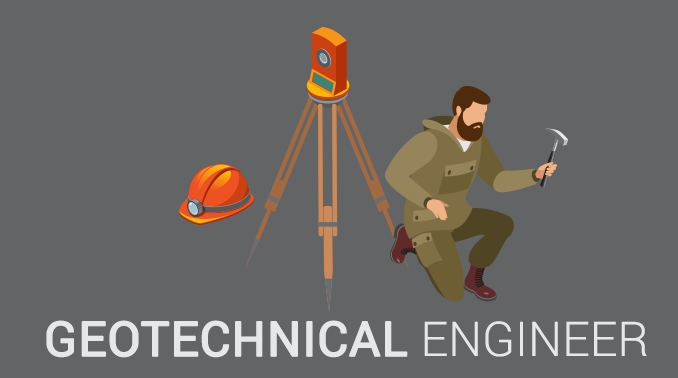Examine This Report on Geotheta
Examine This Report on Geotheta
Blog Article
8 Simple Techniques For Geotheta
Table of ContentsThe smart Trick of Geotheta That Nobody is DiscussingRumored Buzz on GeothetaAll about GeothetaThe Basic Principles Of Geotheta The 6-Minute Rule for Geotheta

They carry out website examinations, gather examples, execute lab tests, and analyze data to examine the suitability of the ground for construction jobs - Tailings Engineer. Based on their searchings for, geotechnical designers provide recommendations for structure style, incline security, keeping frameworks, and reduction of geotechnical threats. They work together with various other experts, such as designers, architectural designers, and building teams, to make certain that geotechnical factors to consider are integrated into the overall project style and implementation
By evaluating the behavior and properties of dirt and rock, they can identify prospective geotechnical dangers such as landslides, dirt negotiation, or incline instability. Their competence helps stop failures or crashes that might threaten lives and property. Below are some detailed tasks and duties of a geotechnical engineer: Site Examination: Geotechnical designers conduct website investigations to collect information on subsurface conditions.
They interpret the data to understand the residential or commercial properties and habits of the dirt and rock, including their toughness, leaks in the structure, compaction qualities, and groundwater problems. Geotechnical Analysis and Design: Geotechnical designers examine the data gathered throughout website examinations to analyze the stability and viability of the site for construction tasks. They perform geotechnical estimations and modeling to examine factors such as bearing capability, settlement, slope stability, lateral earth pressures, and groundwater circulation.
Geotheta - Questions
Structure Style: Geotechnical engineers play a critical duty in developing foundations that can securely sustain the desired structure. They evaluate the soil conditions and tons requirements to establish the suitable foundation kind, such as superficial foundations (e.g., grounds), deep foundations (e.g (https://triberr.com/geotheta)., heaps), or specialized methods like dirt enhancement. They think about elements such as negotiation limitations, bearing ability, and soil-structure interaction to create optimal foundation layouts
They review building and construction strategies, display site activities, and carry out area examinations to validate that the style referrals are adhered to. If unpredicted geotechnical concerns arise, they evaluate the circumstance and give recommendations for removal or modifications to the design. Risk Evaluation and Mitigation: Geotechnical designers assess geotechnical risks and threats linked with the project website, such as landslides, liquefaction, or soil disintegration.

Cooperation and Communication: Geotechnical engineers function closely with various other professionals included in a job, such as engineers, architectural engineers, and construction teams. Efficient communication and partnership are important to integrate geotechnical factors to consider into the total task layout and building and construction procedure. Geotechnical designers offer technical competence, response queries, and make sure that geotechnical requirements are met.
The Basic Principles Of Geotheta
Here are some kinds of geotechnical engineers: Structure Engineer: Foundation engineers concentrate on designing and evaluating foundations for frameworks. They evaluate the soil problems, load demands, and site attributes to determine the most suitable structure kind and style, such as shallow structures, deep foundations, or specialized techniques like stack structures.
They review the factors influencing incline security, such as soil homes, groundwater problems, and incline geometry, and establish strategies to avoid incline failures and alleviate risks. Quake Engineer: Earthquake engineers focus on analyzing and developing frameworks to endure seismic pressures. They assess the seismic threat of a website, assess dirt liquefaction possibility, and create seismic design requirements to guarantee the security and resilience of frameworks during earthquakes.
They execute field screening, accumulate samples, and analyze the accumulated data to define the soil residential or commercial properties, geologic developments, and groundwater conditions at a additional reading site. Geotechnical Instrumentation Engineer: Geotechnical instrumentation designers concentrate on surveillance and measuring the behavior of dirt, rock, and structures. They install and maintain instrumentation systems that check elements such as dirt settlement, groundwater levels, slope movements, and structural displacements to examine efficiency and provide early warnings of prospective concerns.
The 3-Minute Rule for Geotheta
They carry out tests such as triaxial tests, loan consolidation examinations, straight shear examinations, and permeability tests to gather information for geotechnical analysis and layout. Geosynthetics Engineer: Geosynthetics engineers concentrate on the layout and application of geosynthetic materials, such as geotextiles, geogrids, and geomembranes. They utilize these products to enhance dirt stability, enhance slopes, provide drainage services, and control erosion.
They tend to be investigative individuals, which implies they're intellectual, introspective, and analytical. They are interested, methodical, rational, logical, and rational. Some of them are also social, meaning they're kind, charitable, participating, individual, caring, helpful, understanding, sensible, and pleasant - Consulting Engineers.
In the workplace setting, geotechnical designers make use of specialized software program tools to do computations, produce layouts, and analyze data. They prepare reports, testimonial project requirements, interact with customers and group members, and coordinate job activities. The office setting offers a favorable environment for study, evaluation, and collaboration with various other experts involved in the job.
Everything about Geotheta
They often see job sites to carry out site examinations, evaluate geotechnical problems, and gather data for evaluation. These check outs include taking a trip to different locations, in some cases in remote or tough surfaces. Geotechnical engineers may perform dirt sampling, conduct examinations, and screen building and construction activities to guarantee that the geotechnical aspects of the project are being applied appropriately.
Geotechnical engineers likewise operate in specialized geotechnical labs. In these centers, they carry out experiments, execute examinations on dirt and rock samples, and examine the design properties of the materials. Geotechnical lab designers work thoroughly in these atmospheres, managing screening equipment, operating instruments, and taping data. They work together with other laboratory team to make sure exact and trusted screening results.
Report this page